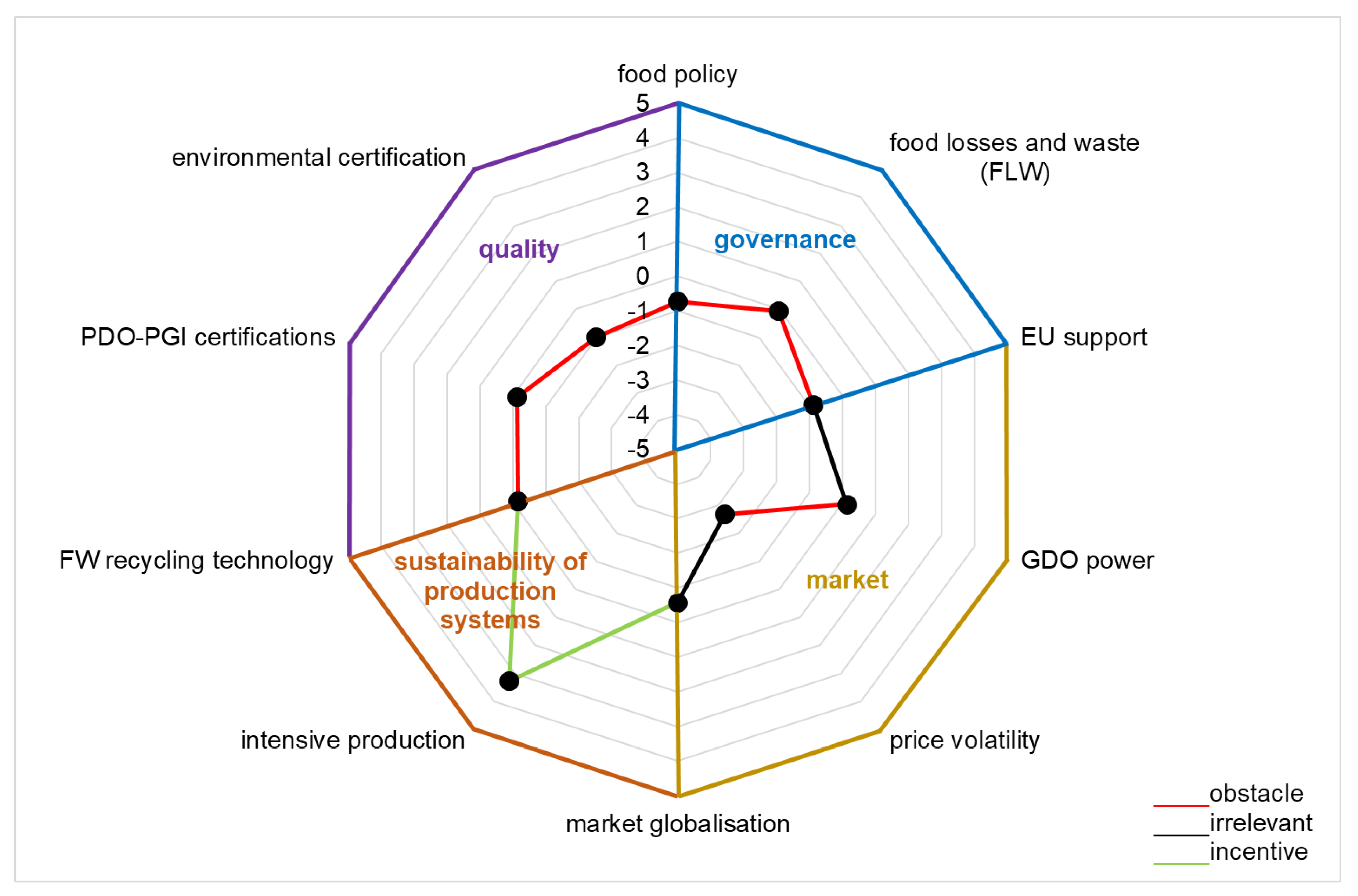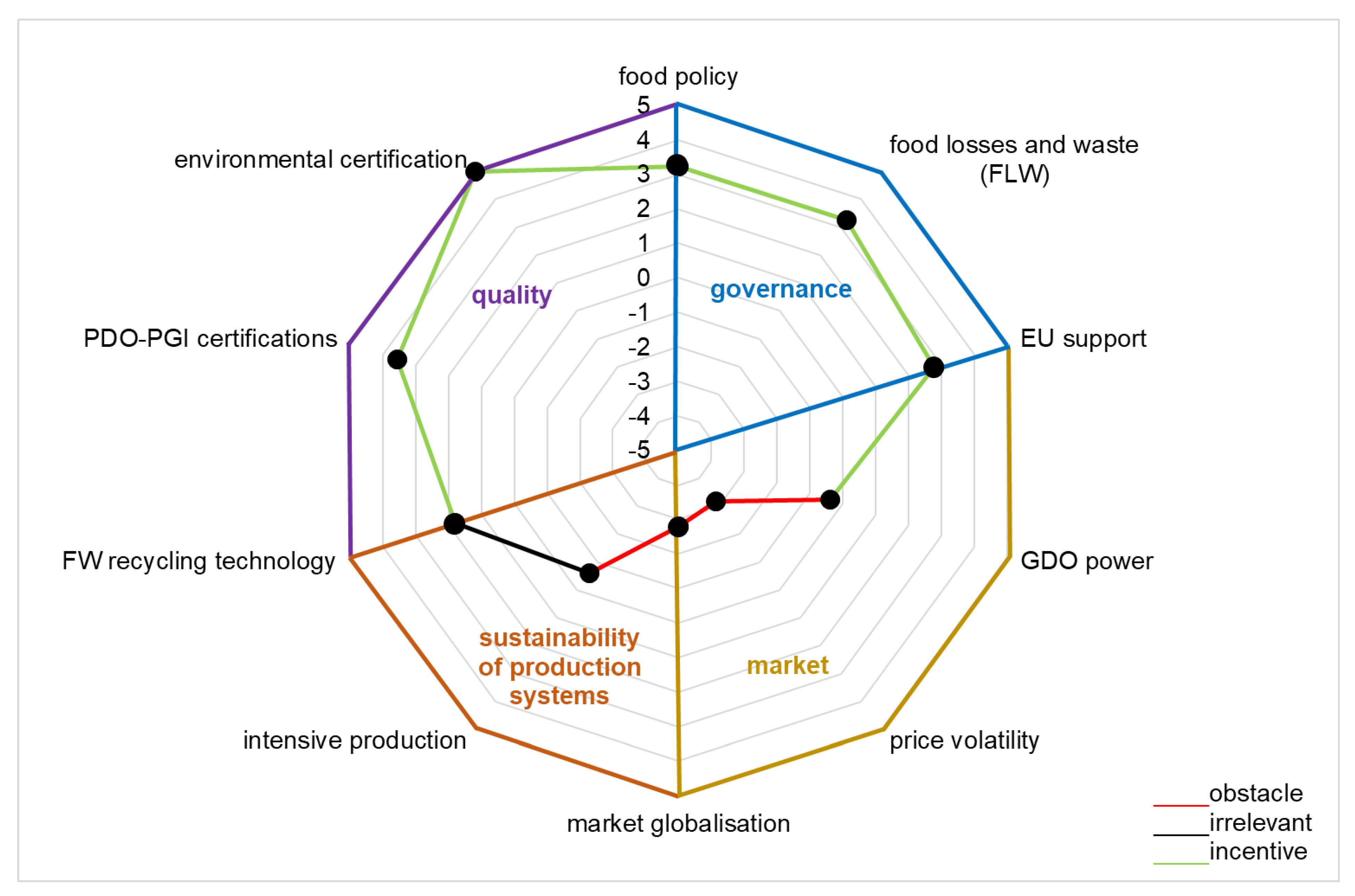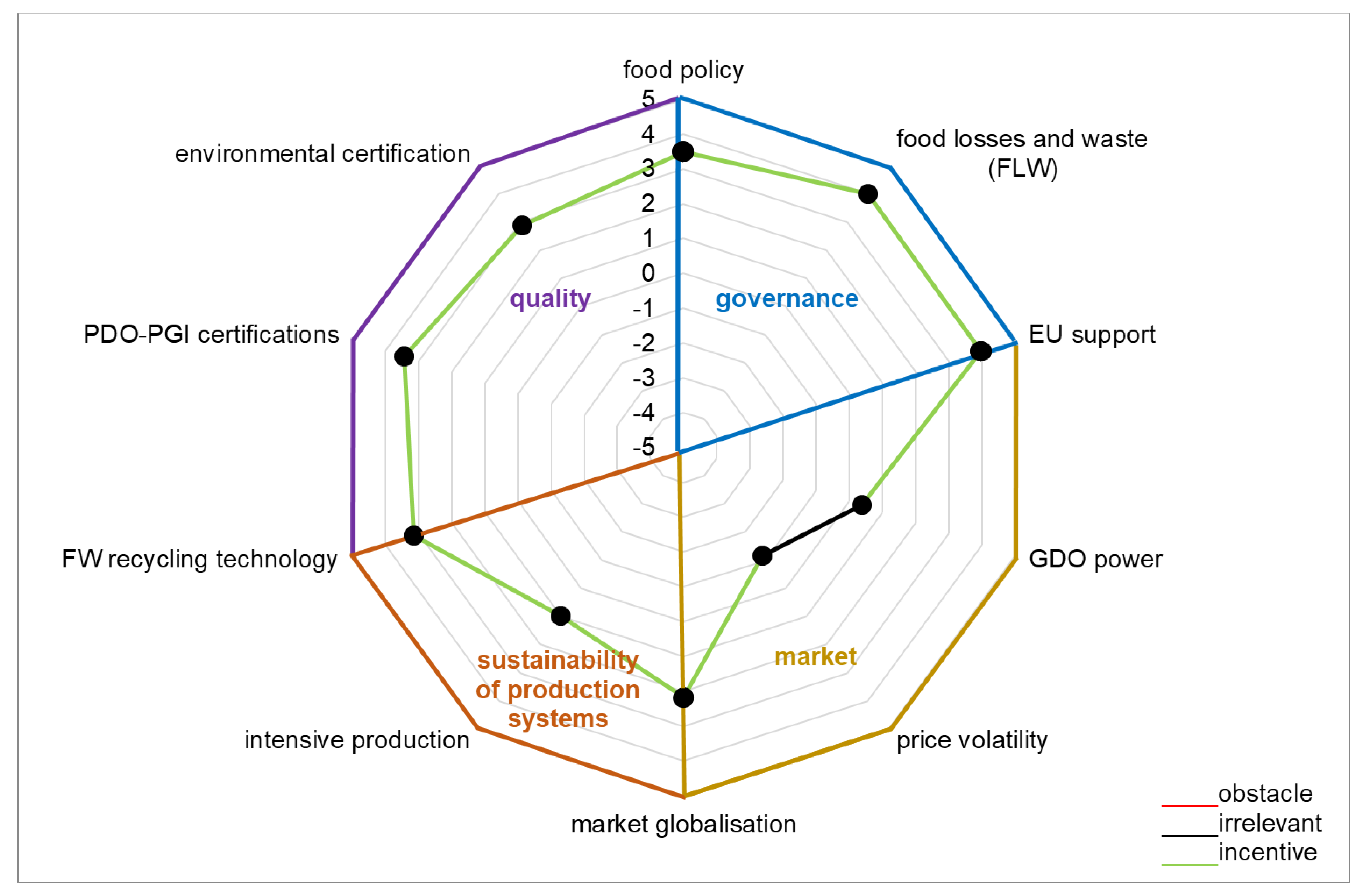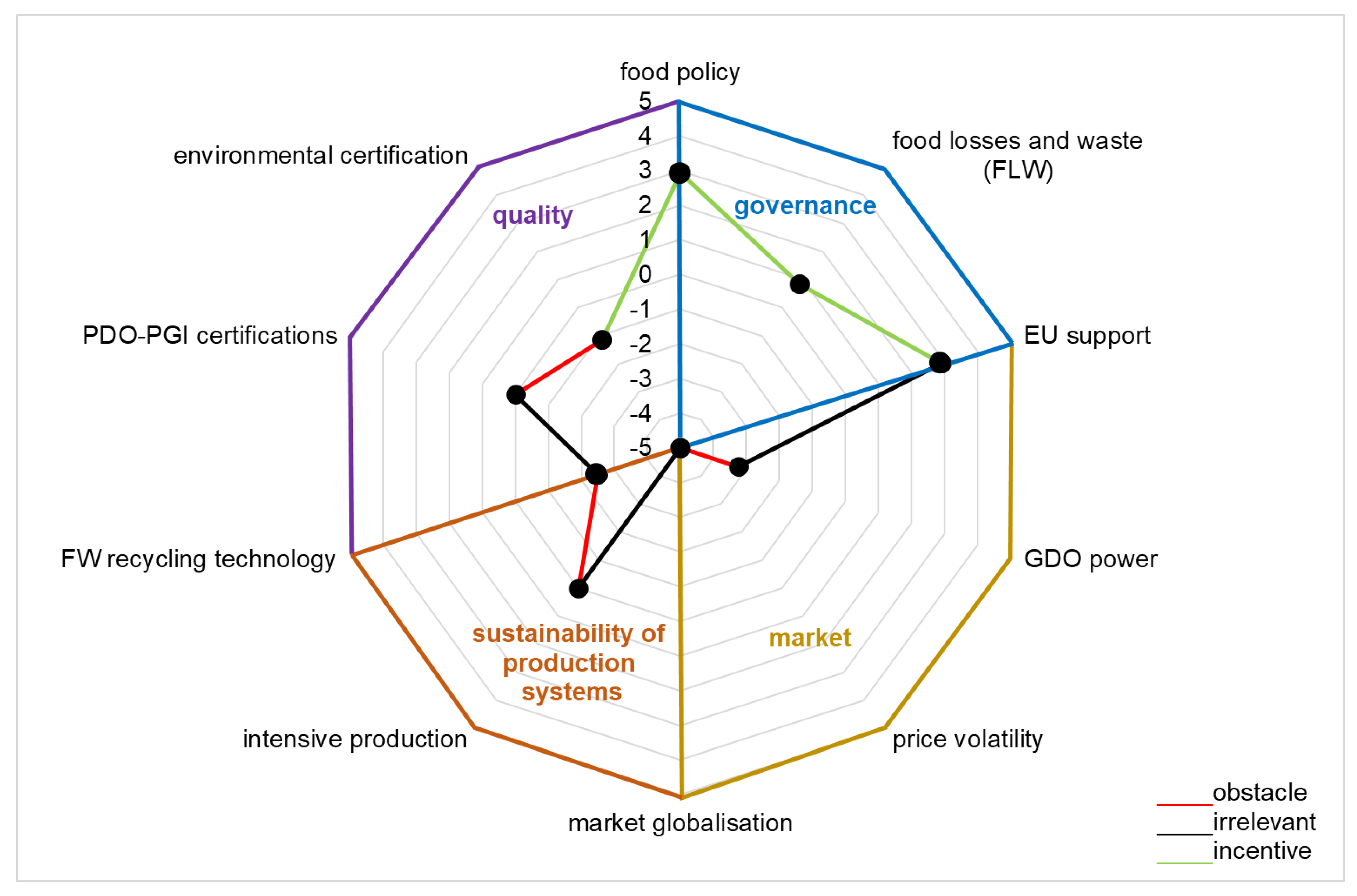Profiling Citizens on Perception of Key Factors of Food Security: An Application of K-Means Cluster Analysis
Abstract
1. Introduction
2. Materials and Methods
2.1. Data Collection and Participants
2.2. Data Analysis
3. Results and Discussion
3.1. Sample Description
3.2. Principal Component Analysis
3.3. Cluster Analysis
4. Conclusions
Author Contributions
Funding
Institutional Review Board Statement
Informed Consent Statement
Data Availability Statement
Acknowledgments
Conflicts of Interest
References
- Alade, A.V.; Ureki, A.I.; Adekoya, C.O. Reflection on Possible Role of Academic Libraries in Facilitating Post-COVID-19 Food Security. IDD 2023. ahead-of-print. [Google Scholar] [CrossRef]
- Food and Agriculture Organization. Rome Declaration on World Food Security and World Food Summit Plan of Action: World Food Summit 13–17 November 1996, Rome, Italy; FAO: Rome, Italy, 1996; ISBN 92-5-103939-9. [Google Scholar]
- Kissoly, L.; Fasse, A.; Grote, U. Intensity of Commercialization and the Dimensions of Food Security: The Case of Smallholder Farmers in Rural Tanzania. J. Agribus. Dev. Emerg. Econ. 2020, 10, 731–750. [Google Scholar] [CrossRef]
- Ruiz-Almeida, A.; Rivera-Ferre, M.G. Internationally-Based Indicators to Measure Agri-Food Systems Sustainability Using Food Sovereignty as a Conceptual Framework. Food Sec. 2019, 11, 1321–1337. [Google Scholar] [CrossRef]
- Ingram, J. A Food Systems Approach to Researching Food Security and Its Interactions with Global Environmental Change. Food Sec. 2011, 3, 417–431. [Google Scholar] [CrossRef]
- FAO. The State of Food and Agriculture 2021. Making Agrifood Systems More Resilient to Shocks and Stresses; The State of Food and Agriculture (SOFA): Rome, Italy, 2021. [Google Scholar]
- Guo, J.; Mao, K.; Yuan, Z.; Qin, Z.; Xu, T.; Bateni, S.M.; Zhao, Y.; Ye, C. Global Food Security Assessment during 1961–2019. Sustainability 2021, 13, 14005. [Google Scholar] [CrossRef]
- Zollet, S.; Colombo, L.; De Meo, P.; Marino, D.; McGreevy, S.R.; McKeon, N.; Tarra, S. Towards Territorially Embedded, Equitable and Resilient Food Systems? Insights from Grassroots Responses to COVID-19 in Italy and the City Region of Rome. Sustainability 2021, 13, 2425. [Google Scholar] [CrossRef]
- Nasir, M.A.; Nugroho, A.D.; Lakner, Z. Impact of the Russian–Ukrainian Conflict on Global Food Crops. Foods 2022, 11, 2979. [Google Scholar] [CrossRef]
- Zhan, Y.; Chen, K.Z. Building Resilient Food System amidst COVID-19: Responses and Lessons from China. Agric. Syst. 2021, 190, 103102. [Google Scholar] [CrossRef]
- Boyacι-Gündüz, C.P.; Ibrahim, S.A.; Wei, O.C.; Galanakis, C.M. Transformation of the Food Sector: Security and Resilience during the COVID-19 Pandemic. Foods 2021, 10, 497. [Google Scholar] [CrossRef] [PubMed]
- Van der Ploeg, J.D. From Biomedical to Politico-Economic Crisis: The Food System in Times of COVID-19. J. Peasant Stud. 2020, 47, 944–972. [Google Scholar] [CrossRef]
- Sanderson Bellamy, A.; Furness, E.; Nicol, P.; Pitt, H.; Taherzadeh, A. Shaping More Resilient and Just Food Systems: Lessons from the COVID-19 Pandemic. Ambio 2021, 50, 782–793. [Google Scholar] [CrossRef] [PubMed]
- Shams Esfandabadi, Z.; Ranjbari, M.; Scagnelli, S.D. The Imbalance of Food and Biofuel Markets amid Ukraine-Russia Crisis: A Systems Thinking Perspective. Biofuel Res. J. 2022, 9, 1640–1647. [Google Scholar] [CrossRef]
- Feng, F.; Jia, N.; Lin, F. Quantifying the Impact of Russia–Ukraine Crisis on Food Security and Trade Pattern: Evidence from a Structural General Equilibrium Trade Model. CAER 2023, 15, 241–258. [Google Scholar] [CrossRef]
- FAO. Information Note—The Importance of Ukraine and the Russian Federation for Global Agricultural Markets and the Risks Associated with the War in Ukraine; FAO: Rome, Italy, 2022; p. 41. [Google Scholar]
- FAO. The State of Food Security and Nutrition in the World 2022; FAO: Rome, Italy, 2022; ISBN 978-92-5-136499-4. [Google Scholar]
- Marchetti, S.; Secondi, L. The Economic Perspective of Food Poverty and (In)Security: An Analytical Approach to Measuring and Estimation in Italy. Soc. Indic. Res. 2022, 162, 995–1020. [Google Scholar] [CrossRef] [PubMed]
- Fattibene, D.; Mazzocchi, G.; Antonelli, M.; Marino, D.; Romagnoli, L. Modelling Food Policies in Italian Urban Agendas in the Time of COVID-19: Experiences, Challenges and Opportunities. Cities 2023, 135, 104199. [Google Scholar] [CrossRef]
- Weerabahu, S.K.; Samaranayake, P.; Dasanayaka, S.W.S.; Wickramasinghe, C.N. Challenges of Agri-Food Supply in City Region Food Systems: An Emerging Economy Perspective. J. Agribus. Dev. Emerg. Econ. 2022, 12, 161–182. [Google Scholar] [CrossRef]
- Artioli, F.; Acuto, M.; McArthur, J. The Water-Energy-Food Nexus: An Integration Agenda and Implications for Urban Governance. Political Geogr. 2017, 61, 215–223. [Google Scholar] [CrossRef]
- Isaac, M.; Isakson, S.; Dale, B.; Levkoe, C.; Hargreaves, S.; Méndez, V.; Wittman, H.; Hammelman, C.; Langill, J.; Martin, A.; et al. Agroecology in Canada: Towards an Integration of Agroecological Practice, Movement, and Science. Sustainability 2018, 10, 3299. [Google Scholar] [CrossRef]
- Zasada, I.; Schmutz, U.; Wascher, D.; Kneafsey, M.; Corsi, S.; Mazzocchi, C.; Monaco, F.; Boyce, P.; Doernberg, A.; Sali, G.; et al. Food beyond the City—Analysing Foodsheds and Self-Sufficiency for Different Food System Scenarios in European Metropolitan Regions. City Cult. Soc. 2019, 16, 25–35. [Google Scholar] [CrossRef]
- Filippin, D.; Sarni, A.R.; Rizzo, G.; Baroni, L. Environmental Impact of Two Plant-Based, Isocaloric and Isoproteic Diets: The Vegan Diet vs. the Mediterranean Diet. Int. J. Environ. Res. Public Health 2023, 20, 3797. [Google Scholar] [CrossRef]
- Minotti, B.; Affinita, V.; Calori, A.; Federici, F. The Integration of Food Policies in a Local Administration System: The Case of the Milan Food Policy. Agroecol. Sustain. Food Syst. 2022, 46, 1087–1109. [Google Scholar] [CrossRef]
- Minotti, B.; Cimini, A.; D’Amico, G.; Marino, D.; Mazzocchi, G.; Tarra, S. Food Policy Processes in the City of Rome: A Perspective on Policy Integration and Governance Innovation. Front. Sustain. Food Syst. 2022, 5, 786799. [Google Scholar] [CrossRef]
- Cretella, A. Alternative Food and the Urban Institutional Agenda: Challenges and Insights from Pisa. J. Rural Stud. 2019, 69, 117–129. [Google Scholar] [CrossRef]
- Calafati, A. Cittt e Aree Metropolitane in Italia (Cities and Metropolitan Areas in Italy). SSRN J. 2013. [Google Scholar] [CrossRef]
- Milan Urban Food Policy Pact (MUFPP). Available online: https://www.milanurbanfoodpolicypact.org/ (accessed on 24 April 2023).
- Arcuri, S.; Minotti, B.; Galli, F. Food Policy Integration in Small Cities: The Case of Intermunicipal Governance in Lucca, Italy. J. Rural Stud. 2022, 89, 287–297. [Google Scholar] [CrossRef]
- Sibbing, L.V.; Candel, J.J.L. Realizing Urban Food Policy: A Discursive Institutionalist Analysis of Ede Municipality. Food Sec. 2021, 13, 571–582. [Google Scholar] [CrossRef]
- Mazzocchi, G.; Marino, D. Rome, a Policy without Politics: The Participatory Process for a Metropolitan Scale Food Policy. Int. J. Environ. Res. Public Health 2020, 17, 479. [Google Scholar] [CrossRef] [PubMed]
- FoodSHIFT 2030. Transforming the European Food System towards a Low Carbon, Circular and Plant-Based Future. 2016. Available online: https://foodshift2030.eu/ (accessed on 8 June 2023).
- The Manifesto for Sustainable Food Transition. Available online: https://www.ciba2030.it/ (accessed on 24 April 2023).
- Bimbo, F.; Viscecchia, R.; De Devitiis, B.; Seccia, A.; Roma, R.; De Boni, A. How Do Italian Consumers Value Sustainable Certifications on Fish?—An Explorative Analysis. Sustainability 2022, 14, 3654. [Google Scholar] [CrossRef]
- Mechlem, K. Food Security and the Right to Food in the Discourse of the United Nations. Eur. Law J. 2004, 10, 631–648. [Google Scholar] [CrossRef]
- Revilla, M.A.; Saris, W.E.; Krosnick, J.A. Choosing the Number of Categories in Agree–Disagree Scales. Sociol. Methods Res. 2014, 43, 73–97. [Google Scholar] [CrossRef]
- Robinson, M.A. Using Multi-Item Psychometric Scales for Research and Practice in Human Resource Management: Multi-Item Psychometric Scales. Hum. Resour. Manag. 2018, 57, 739–750. [Google Scholar] [CrossRef]
- Festing, M.; Knappert, L.; Kornau, A. Gender-Specific Preferences in Global Performance Management: An Empirical Study of Male and Female Managers in a Multinational Context. Hum. Resour. Manag. 2015, 54, 55–79. [Google Scholar] [CrossRef]
- Wilk-Woźniak, E.; Ligęza, S.; Shubert, E. Effect of Water Quality on Phytoplankton Structure in Oxbow Lakes under Anthropogenic and Non-Anthropogenic Impacts: Effect of Water Quality on Phytoplankton Structure in Oxbow Lakes. Clean Soil Air Water 2014, 42, 421–427. [Google Scholar] [CrossRef]
- Behera, P.P.; Singh, S.K.; Sivasankarreddy, K.; Majhi, P.K.; Reddy, B.J.; Singh, D.K. Yield Attributing Traits of High Zinc Rice (Oryza sativa L.) Genotypes with Special Reference to Principal Component Analysis. Environ. Conserv. J. 2022, 23, 458–470. [Google Scholar] [CrossRef]
- Lever, J.; Krzywinski, M.; Altman, N. Principal Component Analysis. Nat. Methods 2017, 14, 641–642. [Google Scholar] [CrossRef]
- Akbar, T.A.; Javed, A.; Ullah, S.; Ullah, W.; Pervez, A.; Akbar, R.A.; Javed, M.F.; Mohamed, A.; Mohamed, A.M. Principal Component Analysis (PCA)–Geographic Information System (GIS) Modeling for Groundwater and Associated Health Risks in Abbottabad, Pakistan. Sustainability 2022, 14, 14572. [Google Scholar] [CrossRef]
- Brejda, J.J.; Karlen, D.L.; Smith, J.L.; Allan, D.L. Identification of Regional Soil Quality Factors and Indicators II. Northern Mississippi Loess Hills and Palouse Prairie. Soil Sci. Soc. Am. J. 2000, 64, 2125–2135. [Google Scholar] [CrossRef]
- Yeomans, K.A.; Golder, P.A. The Guttman-Kaiser Criterion as a Predictor of the Number of Common Factors. Statistician 1982, 31, 221. [Google Scholar] [CrossRef]
- Jolliffe, I.T.; Cadima, J. Principal Component Analysis: A Review and Recent Developments. Phil. Trans. R. Soc. A 2016, 374, 20150202. [Google Scholar] [CrossRef] [PubMed]
- Ramette, A. Multivariate Analyses in Microbial Ecology: Multivariate Analyses in Microbial Ecology. FEMS Microbiol. Ecol. 2007, 62, 142–160. [Google Scholar] [CrossRef] [PubMed]
- Beane, T.P.; Ennis, D.M. Market Segmentation: A Review. Eur. J. Mark. 1987, 21, 20–42. [Google Scholar] [CrossRef]
- Han, J.; Pei, J.; Tong, H. Data Mining: Concepts and Techniques; Morgan Kaufmann: Burlington, MA, USA, 2022; ISBN 0-12-811761-3. [Google Scholar]
- Carvalho, M.J.; Melo-Gonçalves, P.; Teixeira, J.C.; Rocha, A. Regionalization of Europe Based on a K-Means Cluster Analysis of the Climate Change of Temperatures and Precipitation. Phys. Chem. Earth Parts A/B/C 2016, 94, 22–28. [Google Scholar] [CrossRef]
- Javadi, S.; Hashemy, S.M.; Mohammadi, K.; Howard, K.W.F.; Neshat, A. Classification of Aquifer Vulnerability Using K-Means Cluster Analysis. J. Hydrol. 2017, 549, 27–37. [Google Scholar] [CrossRef]
- Tleis, M.; Callieris, R.; Roma, R. Segmenting the Organic Food Market in Lebanon: An Application of k-Means Cluster Analysis. Br. Food J. 2017, 119, 1423–1441. [Google Scholar] [CrossRef]
- Weatherill, G.; Burton, P.W. Delineation of Shallow Seismic Source Zones Using K -Means Cluster Analysis, with Application to the Aegean Region. Geophys. J. Int. 2009, 176, 565–588. [Google Scholar] [CrossRef]
- Callieris, R.; Rocco, R.; BRAHIM, S. Different Consumer Behaviours for Organic Food in Tunisia. A Cluster Analysis Application. New Medit. 2016, 15, 53. [Google Scholar]
- Calori, A.; Dansero, E.; Pettenati, G.; Toldo, A. Urban Food Planning in Italian Cities: A Comparative Analysis of the Cases of Milan and Turin. Agroecol. Sustain. Food Syst. 2017, 41, 1026–1046. [Google Scholar] [CrossRef]
- Amolegbe, K.B.; Upton, J.; Bageant, E.; Blom, S. Food Price Volatility and Household Food Security: Evidence from Nigeria. Food Policy 2021, 102, 102061. [Google Scholar] [CrossRef]
- Mahmoud Sayed Agbo, H. Forecasting Agricultural Price Volatility of Some Export Crops in Egypt Using ARIMA/GARCH Model. Rev. Econ. Political Sci. 2023, 8, 123–133. [Google Scholar] [CrossRef]
- Duarte, G.V.; Ozaki, V.A. Pricing Crop Revenue Insurance Using Parametric Copulas. Rev. Bras. Econ. 2019, 73, 325–343. [Google Scholar] [CrossRef]
- Giller, K.E.; Delaune, T.; Silva, J.V.; Descheemaeker, K.; van de Ven, G.; Schut, A.G.T.; van Wijk, M.; Hammond, J.; Hochman, Z.; Taulya, G.; et al. The Future of Farming: Who Will Produce Our Food? Food Sec. 2021, 13, 1073–1099. [Google Scholar] [CrossRef]
- Boylan, S.; Sainsbury, E.; Thow, A.-M.; Degeling, C.; Craven, L.; Stellmach, D.; Gill, T.P.; Zhang, Y. A Healthy, Sustainable and Safe Food System: Examining the Perceptions and Role of the Australian Policy Actor Using a Delphi Survey. Public Health Nutr. 2019, 22, 2921–2930. [Google Scholar] [CrossRef] [PubMed]
- Del Valle, M.M.; Shields, K.; Alvarado Vázquez Mellado, A.S.; Boza, S. Food Governance for Better Access to Sustainable Diets: A Review. Front. Sustain. Food Syst. 2022, 6, 784264. [Google Scholar] [CrossRef]
- Tran, D.; Goto, D. Impacts of Sustainability Certification on Farm Income: Evidence from Small-Scale Specialty Green Tea Farmers in Vietnam. Food Policy 2019, 83, 70–82. [Google Scholar] [CrossRef]
- Martin, C.; Evans, J.; Karvonen, A.; Paskaleva, K.; Yang, D.; Linjordet, T. Smart-Sustainability: A New Urban Fix? Sustain. Cities Soc. 2019, 45, 640–648. [Google Scholar] [CrossRef]
- De Boni, A.; Melucci, F.M.; Acciani, C.; Roma, R. Community Composting: A Multidisciplinary Evaluation of an Inclusive, Participative, and Eco-Friendly Approach to Biowaste Management. Clean. Environ. Syst. 2022, 6, 100092. [Google Scholar] [CrossRef]
- Minervini, F.; Comitini, F.; De Boni, A.; Fiorino, G.M.; Rodrigues, F.; Tlais, A.Z.A.; Carafa, I.; De Angelis, M. Sustainable and Health-Protecting Food Ingredients from Bioprocessed Food by-Products and Wastes. Sustainability 2022, 14, 15283. [Google Scholar] [CrossRef]
- Mondéjar-Jiménez, J.-A.; Ferrari, G.; Secondi, L.; Principato, L. From the Table to Waste: An Exploratory Study on Behaviour towards Food Waste of Spanish and Italian Youths. J. Clean. Prod. 2016, 138, 8–18. [Google Scholar] [CrossRef]




| Socio-Economic Variable | Frequency (No.) | Frequency (%) | Cumulative Frequency (%) | |
|---|---|---|---|---|
| gender | Male | 323 | 54 | 54 |
| Female | 229 | 38 | 92 | |
| No answer | 48 | 8 | 100 | |
| Tot. | 600 | 100 | ||
| age (years) | 20–29 | 135 | 23 | 23 |
| 30–39 | 180 | 30 | 53 | |
| 40–49 | 82 | 14 | 67 | |
| 50–59 | 110 | 18 | 85 | |
| 60–69 | 85 | 14 | 99 | |
| >70 | 8 | 1 | 100 | |
| Tot. | 600 | 100 | ||
| education | Compulsory school | 88 | 15 | 15 |
| High school | 261 | 44 | 58 | |
| University or postgraduate degree | 251 | 42 | 100 | |
| Tot. | 600 | 100 | ||
| income | Less than 25,000 €/year | 158 | 26 | 26 |
| From 25,100 to 40,000 €/year | 271 | 45 | 72 | |
| From 40,100 to 60,000 €/year | 134 | 22 | 94 | |
| More than 60,000 €/year | 37 | 6 | 100 | |
| Tot. | 600 | 100 | ||
| employment | Employee | 382 | 64 | 64 |
| Worker | 77 | 13 | 77 | |
| Unemployed | 14 | 2 | 79 | |
| Freelancer | 75 | 13 | 91 | |
| Student | 52 | 9 | 100 | |
| Tot. | 600 | 100 | ||
| Item | Frequency of the Initial Sample (%) | Frequency of the Final Sample (%) | ||||
|---|---|---|---|---|---|---|
| Obstacle | Irrelevant | Incentive | Obstacle | Irrelevant | Incentive | |
| agricultural diversification | 5.2 | 59.5 | 35.3 | 10.3 | 29.4 | 60.3 |
| banking service | 22.3 | 29.7 | 48.0 | 21.3 | 28.0 | 50.7 |
| blockchain | 5.7 | 44.0 | 50.3 | 5.5 | 20.6 | 73.9 |
| BRC certification | 5.2 | 62.3 | 32.5 | 8.9 | 12.2 | 78.9 |
| climate change | 9.5 | 36.2 | 54.3 | 67.4 | 5.5 | 27.1 |
| cloud online | 34.5 | 49.7 | 15.8 | 5.0 | 20.4 | 74.6 |
| community-supported agriculture (CSA)/farmers market | 6.0 | 53.2 | 40.8 | 6.9 | 14.9 | 78.2 |
| consumer services | 6.5 | 59.7 | 33.8 | 8.9 | 12.2 | 78.9 |
| corporate social responsibility | 3.5 | 42.0 | 54.5 | 14.4 | 7.8 | 77.8 |
| credit assurance | 21.0 | 43.5 | 35.5 | 11.0 | 15.6 | 73.4 |
| crop genome adaptation | 37.7 | 42.3 | 20.0 | 67.4 | 5.5 | 27.1 |
| environmental certification | 5.5 | 20.5 | 74.0 | 5.3 | 19.0 | 75.7 |
| EU support | 10.0 | 18.0 | 72.0 | 5.3 | 11.0 | 83.7 |
| food banks | 7.3 | 41.0 | 51.7 | 5.3 | 11.2 | 83.5 |
| food loss and waste (FLW) | 7.2 | 9.3 | 83.5 | 13.8 | 15.8 | 70.4 |
| food policy | 6.2 | 5.4 | 88.5 | 6.2 | 5.8 | 88.0 |
| food waste recycling technology | 12.5 | 15.5 | 72.0 | 7.6 | 19.0 | 73.4 |
| LSR power | 46.5 | 10.5 | 43.0 | 47.0 | 8.5 | 44.5 |
| generational handover | 28.8 | 30.7 | 40.5 | 12.4 | 15.4 | 72.2 |
| governance | 22.5 | 39.2 | 38.3 | 12.4 | 11.9 | 75.7 |
| green energy | 20.8 | 68.8 | 10.4 | 7.1 | 24.3 | 68.6 |
| ICT services | 5.2 | 49.7 | 45.1 | 5.3 | 3.7 | 91.0 |
| illegal hiring | 6.8 | 61.8 | 31.3 | 8.7 | 20.0 | 71.3 |
| innovation transfer | 4.7 | 53.7 | 41.7 | 6.2 | 12.4 | 81.4 |
| intensive production | 34.3 | 16.0 | 49.7 | 32.6 | 17.2 | 50.2 |
| local varieties | 10.0 | 18.3 | 71.7 | 8.9 | 12.2 | 78.9 |
| market globalisation | 51.7 | 8.2 | 40.2 | 51.6 | 6.7 | 41.7 |
| nutrition label | 15.6 | 48.5 | 35.9 | 6.7 | 14.7 | 78.6 |
| organic food | 21.7 | 34.3 | 44.0 | 21.8 | 12.6 | 65.6 |
| PDO–PGI | 5.8 | 10.8 | 83.3 | 6.0 | 16.1 | 77.9 |
| price volatility | 73.5 | 11.0 | 15.5 | 74.1 | 11.0 | 14.9 |
| private labels | 6.0 | 53.2 | 40.8 | 12.2 | 25.2 | 62.6 |
| protected land | 5.5 | 82.8 | 11.7 | 10.3 | 17.0 | 72.7 |
| public support | 7.3 | 70.1 | 22.6 | 9.2 | 17.0 | 73.8 |
| QR codes | 20.0 | 54.2 | 25.8 | 5.5 | 25.0 | 69.5 |
| qualification of the workforce | 12.0 | 51.5 | 36.5 | 5.7 | 9.6 | 84.7 |
| quality control | 7.2 | 55.2 | 37.6 | 8.0 | 7.8 | 84.2 |
| quality diversification | 10.0 | 33.7 | 56.3 | 19.3 | 16.5 | 64.2 |
| rating online | 12.2 | 49.0 | 38.8 | 19.0 | 31.9 | 49.1 |
| research and development (R&D) | 15.3 | 63.3 | 21.4 | 4.6 | 12.4 | 83.0 |
| risk management | 8.5 | 56.1 | 35.4 | 16.5 | 6.4 | 77.1 |
| social certification | 12.0 | 43.0 | 45.0 | 6.7 | 17.9 | 75.4 |
| stable supply chain | 13.2 | 51.1 | 35.7 | 20.9 | 11.9 | 67.2 |
| traceability | 7.3 | 75.0 | 17.7 | 7.1 | 24.3 | 68.6 |
| urban agriculture | 5.5 | 74.0 | 20.5 | 21.3 | 28.0 | 50.7 |
| value-added | 20.5 | 32.2 | 47.3 | 10.3 | 13.5 | 76.2 |
| Principal Component (PC) | Initial Eigenvalues | ||
|---|---|---|---|
| Total | Variance (%) | Cumulative (%) | |
| PC-1 | 16.5 | 43.4 | 43.4 |
| PC-2 | 2.6 | 6.8 | 50.2 |
| PC-3 | 1.9 | 4.9 | 55.1 |
| PC-4 | 1.6 | 4.2 | 59.3 |
| PC-5 | 1.5 | 4.0 | 63.3 |
| PC-6 | 1.4 | 3.6 | 63.8 |
| PC-7 | 1.0 | 2.7 | 69.6 |
| PC-8 | 1.0 | 2.6 | 72.2 |
| Variable | PC-1 (Governance) |
| food policy | 0.803 |
| social certification | 0.751 |
| illegal hiring | 0.667 |
| Variable | PC-2 (Market) |
| price volatility | 0.705 |
| LSR power | 0.661 |
| market globalisation | 0.582 |
| Variable | PC-3 (Quality) |
| environmental certification | 0.408 |
| quality control | 0.381 |
| PDO–PGI certifications | 0.300 |
| Variable | PC-4 (Sustainability of production systems) |
| food waste recycling technology | 0.516 |
| intensive production | 0.452 |
| food loss and waste (FLW) | 0.329 |
| PC | Cluster 1 | Cluster 2 | Cluster 3 | Cluster 4 |
|---|---|---|---|---|
| PC-1 (Governance) | −1.8 | 0.1 | 0.5 | 0.5 |
| PC-2 (Market) | 0.6 | −0.7 | 0.4 | −0.7 |
| PC-3 (Quality) | −0.1 | 0.6 | −0.2 | −2.8 |
| PC-4 (Sustainability of production systems) | 0.0 | −0.4 | 0.5 | −2.9 |
| Variable | Clusters | |||
|---|---|---|---|---|
| Capitalists | Hedonists | Law-Confidents | Conservatories | |
| Governance macro-area | ||||
| food policy | −0.7 | 3.2 | 3.5 | 2.9 |
| food loss and waste (FLW) | −0.1 | 3.3 | 4.0 | 0.8 |
| EU support | −0.9 | 2.8 | 4.0 | 2.9 |
| Market macro-area | ||||
| LSR power | 0.1 | −0.4 | 0.4 | −3.3 |
| price volatility | −2.7 | −3.2 | −1.2 | −5.0 |
| market globalisation | −0.6 | −2.8 | 2.2 | −5.0 |
| Sustainability of production systems macro-area | ||||
| intensive production | 3.3 | −0.6 | 1.1 | 0.0 |
| food waste recycling technology | −0.1 | 1.8 | 3.2 | −2.5 |
| Quality macro-area | ||||
| PDO–PGI certifications | −0.1 | 3.6 | 3.4 | 0.0 |
| environmental certification | −1.0 | 5.0 | 2.9 | −1.2 |
| cluster size (%) | 15 | 36 | 45 | 4 |
Disclaimer/Publisher’s Note: The statements, opinions and data contained in all publications are solely those of the individual author(s) and contributor(s) and not of MDPI and/or the editor(s). MDPI and/or the editor(s) disclaim responsibility for any injury to people or property resulting from any ideas, methods, instructions or products referred to in the content. |
© 2023 by the authors. Licensee MDPI, Basel, Switzerland. This article is an open access article distributed under the terms and conditions of the Creative Commons Attribution (CC BY) license (https://creativecommons.org/licenses/by/4.0/).
Share and Cite
Facendola, R.; Ottomano Palmisano, G.; De Boni, A.; Acciani, C.; Roma, R. Profiling Citizens on Perception of Key Factors of Food Security: An Application of K-Means Cluster Analysis. Sustainability 2023, 15, 9915. https://doi.org/10.3390/su15139915
Facendola R, Ottomano Palmisano G, De Boni A, Acciani C, Roma R. Profiling Citizens on Perception of Key Factors of Food Security: An Application of K-Means Cluster Analysis. Sustainability. 2023; 15(13):9915. https://doi.org/10.3390/su15139915
Chicago/Turabian StyleFacendola, Rosalia, Giovanni Ottomano Palmisano, Annalisa De Boni, Claudio Acciani, and Rocco Roma. 2023. "Profiling Citizens on Perception of Key Factors of Food Security: An Application of K-Means Cluster Analysis" Sustainability 15, no. 13: 9915. https://doi.org/10.3390/su15139915
APA StyleFacendola, R., Ottomano Palmisano, G., De Boni, A., Acciani, C., & Roma, R. (2023). Profiling Citizens on Perception of Key Factors of Food Security: An Application of K-Means Cluster Analysis. Sustainability, 15(13), 9915. https://doi.org/10.3390/su15139915








